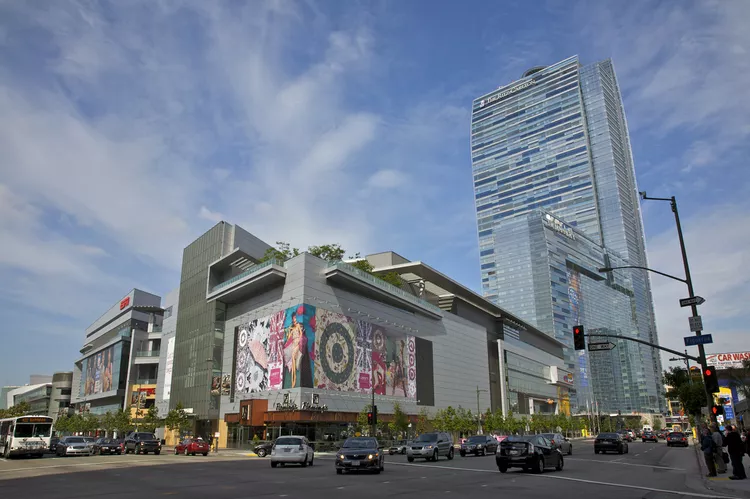Summary
- Visiting Information
- Why You Should Go
- 4th Floor Exhibits – History of American Music and Songwriters Hall
- 3rd Floor Exhibits – Making Music, the Recording Industry and the GRAMMYs
- 2nd Floor – Clive Davis Theater, Museum Programs, Special Exhibits
- The GRAMMY Walk of Fame
- Room for Improvement – It Could Be So Much Better!
Visiting Information
Tickets: Tickets can be purchased at the Box Office or online.
Time Needed: Three hours to all day depending on your level of interest and how long you want to stand. 90 minutes if you’re just hitting a few highlights.
Metro: Blue Line to Pico Station (2.5 blocks); Red, Purple or Blue Line to 7th Street Station (3.5 blocks).
Parking: There is no dedicated parking for the GRAMMY Museum, but there are many parking lots surrounding L.A. Live with prices from $3 to $35, depending on location and events going on. Even during events, you can usually find $5 parking within 2 blocks or so of L.A. Live. Check losangeles.bestparking.com to compare rates at surrounding lots and garages (rates may not be up to date, but close).
Address: Although the address is on Olympic, the entrance is on Figueroa, just north of the Farm of Beverly Hills restaurant. The Box Office is on the front of the building. An elevator in the lobby takes you to the 4th floor to begin your exploration of the GRAMMY Museum and you work your way down from there. Most of the content is on the 3rd and 4th floors.
800 W Olympic Blvd (entrance on Figueroa)
Los Angeles, CA 90015
(213) 765-6800
Why You Should Go
The GRAMMY Museum is a fantastic destination for music enthusiasts, featuring a comprehensive look into the history of music, various genres, and the prestigious GRAMMY awards. The interactive activities allow guests to engage with instruments and music technology, providing an enriching experience.
However, if you’re not particularly interested in music history or its evolution, this museum may not appeal to you.
For music lovers, the GRAMMY Museum offers an extensive collection that is truly impressive. Despite some design challenges that detract from the experience, I highly recommend visiting since there is an abundance of compelling content to engage with. My own experience was significant; although I was told to allow 90 minutes, I found that even three hours was insufficient to fully appreciate everything on display.
4th Floor Exhibits – History of American Music and Songwriters Hall
Upon arriving on the 4th floor, you may find the layout a bit confusing. You’ll enter a gallery featuring various GRAMMY awards that highlight design changes throughout the years. The main galleries are located behind the GRAMMY Museum sign, which is flanked by red neon suits worn by Daft Punk.
The Crossroads exhibit features a touch-screen table showcasing music genres. By interacting with this exhibit, you can explore how different genres have influenced one another.
The Music Epicenters exhibit provides a historical timeline of pivotal moments in American music, while the Culture Shock exhibit examines music’s intersection with socio-political changes over the last 50 years.
There is also the Songwriters Hall of Fame Gallery, which showcases original handwritten lyrics and offers interactive stations for songwriting collaboration. However, the execution of these features can be frustrating due to distractions from concurrent audio-visual displays.
3rd Floor Exhibits – Making Music, the Recording Industry and the GRAMMYs
On the 3rd floor, visitors will find a variety of hands-on exhibits. Instruments such as drum kits and congas allow for auditory experiences through headsets, while electric guitars can be used as control panels for sound manipulation. A DJ mix box further invites creativity.
Through In The Studio, visitors discover the intricate process that takes a song to its final recorded form. Listening booths offer insights from industry professionals, while interactive touchscreen displays facilitate sound experimentation.
Furthermore, the museum houses a richly detailed history of the GRAMMY awards, spotlighting legendary artists and charitable efforts undertaken by the Recording Academy.
2nd Floor – Clive Davis Theater, Museum Programs, Special Exhibits
The 2nd floor features the 200-seat Clive Davis Theater, which hosts various musical programs and performances. The museum also includes a shop for memorabilia and space dedicated to temporary exhibits.
Programs often include interviews with music legends, along with performances that celebrate their musical heritage.
The GRAMMY Walk of Fame
If you don’t have the opportunity to enter the GRAMMY Museum, you can experience a slice of GRAMMY history outside at the Recording Academy’s GRAMMY Walk of Fame. This feature recognizes the winners of the major GRAMMY categories from 1958 to 2008, coinciding with the museum’s opening.
Room for Improvement – It Could Be So Much Better!
Having experienced numerous exceptional museums, I believe the GRAMMY Museum has potential that remains untapped, particularly in the realm of exhibit technology. Most visitors may not recognize this opportunity for improvement.
One primary concern is the audio chaos created by simultaneously running video panels, which transforms award-winning music into a confusing soundscape. Moreover, the absence of volume control further detracts from the experience, particularly for younger visitors.
A notable lack of seating in interactive exhibits further exacerbates the challenge, as most museums provide areas to rest and engage meaningfully with the exhibits. Engaging with the content should be an enriching experience, not a rushed encounter, which is currently the case due to a lack of benches or seating options.
In terms of technology, the GRAMMY Museum exhibits are in need of significant updates to enhance the overall visitor experience. By investing in advanced interactive features, the museum could greatly improve its offering, making it more enjoyable for audiences seeking a robust musical experience.





